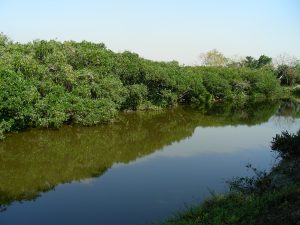CONSERVATION OF MANGROVES
Mangroves are evergreen forest found extensively in the estuarine regions where mud-flats are wide and gently sloping. Besides estuaries, they also inhabit the intertidal regions of shallow bays and creeks where the environment is conducive for the growth of mangroves. They are a complete ecosystem that is a conglomeration of several species of flora, fauna and biotic features in an area and their interaction with each other.
The mangroves are valued for its protection and stabilization of low-lying coastal lands and its importance in estuarine and coastal fishery food chains. Mangroves are flood buffers and they also help in stabilizing the climate by moderating temperature, humidity, wind and even waves. They are specially adapted to withstand salinity, wave action, and can grow in poor soils. They actually protect the land from the impact of the sea.
Mangroves in and around Mumbai have undergone massive destruction. As a result the density of mangroves in and around Mumbai has been on a decline. The main reasons for this depletion are reclamation of land for paddy cultivation, salt pan scheme, reclamation of land for building activities and dumping, industrial pollution of the creeks, cuttings of trees for fuel wood etc.
The mangroves have been afforded protection under Category I of the CRZ (Coastal Zone Regulation 1991). They are also entitled protection under the prevailing forest conservation regime, the Maharashtra Private Forest Act 1975, the Wildlife Protection Act 1972 and the Maharashtra Felling of Trees (Regulation) Act 1964.
The area under mangroves in Maharashtra was 200 km2 in 1972-75, which reduced to 108 km2 in 1997 but increased to 118 km in 2001. According to MMRDA, the mangrove areas in Mumbai have shown significant increase since 1991. However, this claim is under contention, as the maximum numbers of reclamation have taken place between 1991 and 1997. It is believed that about 70 per cent of Mumbai’s mangroves have been destroyed due to various development activities.
This requires efforts to conserve and protect the mangroves. Recognizing the need and importance of mangroves, a Public Interest Litigation was filed by Mr. Debi Goenka in the Bombay High Court, seeking the Court’s intervention to inhibit the destruction of Mangroves. Through the efforts of CAT, about 14500 hectares of mangroves have been notified as forest areas in the state of Maharashtra.
[read PIL 87 of 2006 on Legal page for more details]




